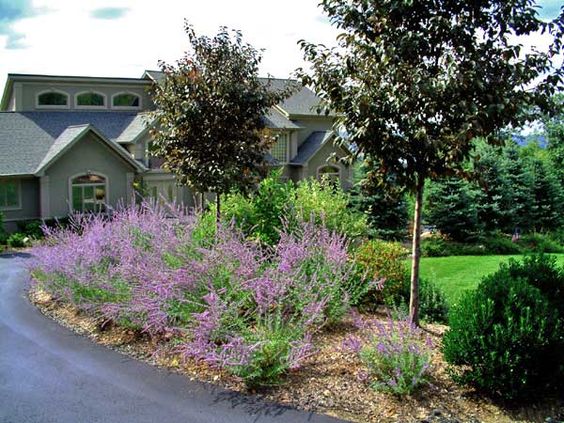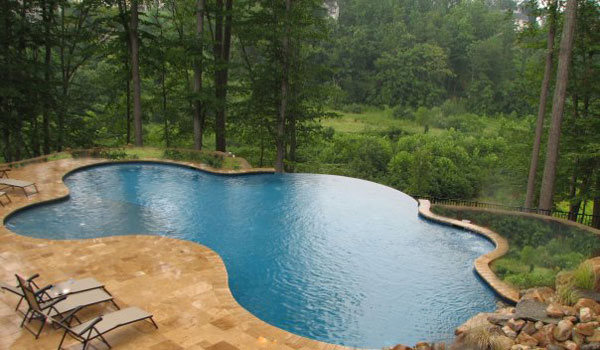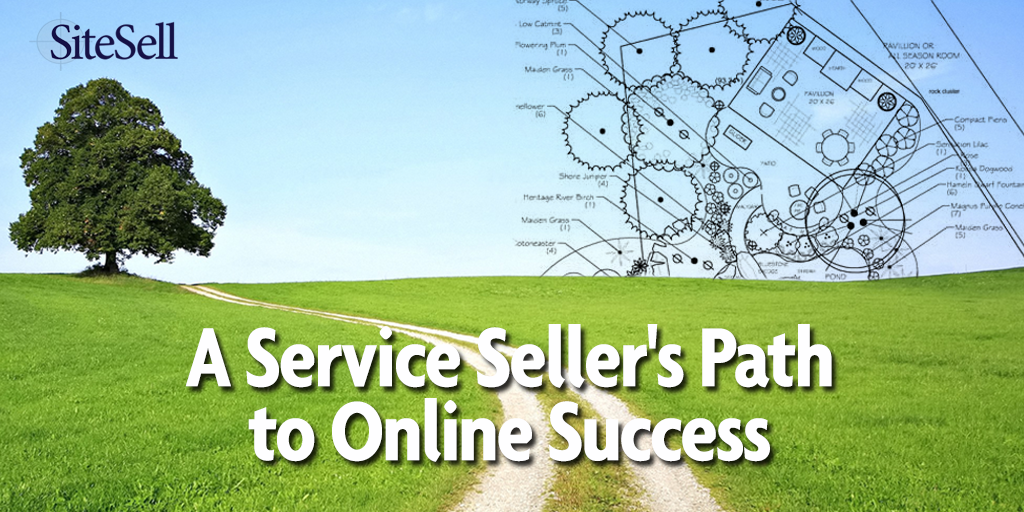Ever wonder how successful solopreneurs “get so lucky?”
I enjoy being able to do something in the middle of the week, or take a vacation when I like.Susan from landscape-design-advice.com
Do you believe in serendipity?
Coined by the English author Horace Walpole in 1754, serendipity means “an aptitude of making fortunate discoveries by accident.” In other words, without looking for it, you stumble upon a great idea that may give your life a completely new direction.
That’s what happened to Susan Schlenger. Repeatedly. How else would you explain that a former retail store owner with a degree in psychology is now a sought-after landscape designer? And not only does she sell her design services locally, she’s making about 50% of her income by selling designs online.
A genius idea that came to Susan serendipitously. 🙂
Let’s hear her story. Along the way, we’ll see how to harness serendipity by making it, well, less serendipitous!
1. How does someone with a degree in psychology and a former retail store owner end up with an online business about landscape design?
Although I got a degree in psychology, I never pursued a career in this field of work. After the retail store failed, I started thinking about what I was going to do with the rest of my life. I decided to go back to school for landscape architecture as I had been very interested in plants for quite awhile.
Later, I started my first website for local designs in 2002. The online business aspect of both my local site www.susanschlenger.com and my more global site www.landscape-design-advice.com evolved over time.

2. What were your initial goals when you started landscape-design-advice.com? Have these goals changed over time?
It’s really rather funny. I had hired someone to help me get my local site higher in search engine rankings. He asked one day if I wanted to put ads on my site. I said “What is that?” and “What do you mean?” He showed me Google AdSense, and I said “Oh no, I don’t want to mess up my beautiful site with all those ugly ads!”
But then I started thinking. Why couldn’t I have another site and put ads on that one? And that was my entire reason for creating landscape-design-advice.com!
Have my goals changed over time? Boy, have they ever! Although I did very well with AdSense, I tried other ways to monetize…affiliates, selling advertising space, eBooks, etc. Over time, a clear winner emerged: selling my online designs.
Susan had to have her brain switched to “ON” to recognize this suggestion as more than what is was intended to be. Your daily life is bombarded with hundreds of “moments”… ads in the subway, business meetings, talks with friends.
Most are just noise and quickly dismissed. Susan’s SEO asked her did she want to “put ads on her site.” Many would have answered NO and just moved on. She was selling a local service after all. But Susan’s “antennae” received this particular moment with a little buzz… perhaps there’s something more here…
“Perhaps I can sell ads on a different kind of site.”
That’s “the aptitude of making fortunate discoveries by accident.” She made the non-obvious connection that comes only if your brain is in a constantly curious state of asking, “what could I do with that?”
Connecting apparently unrelated or semi-related dots is one of the great skills to master in business, big or small. Half skill and half habit, you can train yourself to be open to the great (but partially disguised) ideas that the universe throws your way.
3. Tell us about your philosophy regarding content. How do you know what your prospective customers are looking for? Where does this information come from?
I am lucky with this as I am a Landscape Designer and at this time have almost 20 years experience. I know from my clients what types of information they are looking for, what the problems are, what information is scarce, what they love and sends them over the moon, etc.
I even know which photos resonate with them from my local clients’ reactions to those in my portfolio. I also see from traffic to certain pages, and which types of photos are liked on Pinterest, which directions are best.
1) Insider knowledge and experience in your niche: Your readers will know it when you “live and breathe” your niche. No matter how well you may research a topic, it’s just not the same as first-hand experience. On Day 2 of the SBI! Action Guide you’ll learn how to assess potential site concepts based on these 4 criteria (in addition to keyword demand and competition numbers)…
- How much time do you have to work on your website and online business?
- How monetizable is your niche?
- Are you passionate about the topic?
- Are you knowledgeable about the topic?
2) Analyzing what works and what doesn’t: This starts way before you even begin to build your site, during the all-important planning phase. First comes your keyword research. You’ll evaluate various site concepts and decide about the best one. Then you’ll work out your site structure and create your site’s content blueprint.
After you’ve built some content, and start to get traffic, you’ll analyze your traffic. Where do your visitors come from? Which pages do they like most? What do they click on when they are on your pages?
Sounds overwhelming? Don’t worry. The SBI! Action Guide leads you through the whole process, step-by-step. You’ll also have access to all the tools you need, from keyword brainstorming to analyzing traffic stats.

4. After you provide all this valuable and free information, how do you “upgrade” people from being free content seekers to paying customers?
I have found that it is a matter of them learning what I do, seeing what is possible, learning about my expertise, and then showing them with images, text and infographics what is available to help them, namely my services.
A typical “free visitor to paying customer journey” for me looks like this…
A person, let’s call her Ellie, finds my website through a Google search. She sees a beautiful photo of a sloped front yard. She signs up for my newsletter to get my free eBook. Two weeks later Ellie contacts me and says…
“I saw that photo on your site, and I have a slope and would love to do something like that. How much do you charge for your services?”
In other words, my visitors have come to my site searching for solutions to a problem or for inspiration, and I try to provide them with what they are looking for, and more. I want them to go ‘ooh’ and ‘ahhh’ about the photos and information on my site so much that they simply have to inquire more about me.
So I suppose I urge them on in a subtle way. I also find building an email list and having autoresponders (automatic emails that go out after someone subscribes to my list) get them to know and trust me more.
First, you provide your visitors with the high quality information they were searching for. But you don’t stop there. You over-deliver. Your content (whether this is text, images, video or audio) is so amazing and so well presented that complete strangers develop trust and confidence in you.
That’s what we call the concept of PREselling. Omit this crucial step at your business’s peril.
This is another form of building trust. Susan’s work was published in the October 2016 issue of “This Old House,” a popular home improvement magazine and TV series. Cable shows run repeatedly so folks really get to know you.
How does serendipity come into play here? Don’t bother pitching editors/producers (unless one is a personal friend). Editors know what they’re looking for and they’ll find YOU. All you have to do is say, “YES!!!” Not hard to recognize this as OPPORTUNITY!
5. You use an interesting twist to selling your landscape design services: You are offering them as online design services for people living outside your area, in addition to selling your services locally. How did you come up with this monetization idea, and how has it worked out for you?
I would love to tell you exactly how the idea came to me. Someone may have asked me for a design, someone who did not live in my area. It has worked out better than I could have imagined!
In fact, I’ve just created my first product based on my online designs. It’s a package of 5 downloadable front yard design plans. This is specifically for people who don’t have the budget to purchase a fully customized design, but still want to have a professionally landscaped front yard.
Train yourself to think “opportunity” instead of “too bad” or “no.” You’ll be amazed at the product ideas that will jump out of your head and onto a more profitable web business!
But it only makes you more profitable if you don’t stop at the idea stage. Susan offers customized design work to customers living outside her area via her online design services and she just started selling a fully digital product, her downloadable front yard design plans.
The result? New income streams for her online business, making her business both more profitable and future-proof than before.
The key take-away for your own business? Always be open to receiving ideas. Seriously, 90% of creativity is simply paying attention/being open to what passes by your eyes daily.
6. How long did it take to start earning an income from your site? Is it a full-time income (replaces a job) or a part-time income?
I started earning income with AdSense right away.
A couple of years ago, my online designs grew my total income. They became about 30% of my design business. It is now approaching 50%.
I get many local design jobs now from this site as well, which was a nice surprise. Between the two, it is a full time income. And I’m not done yet!
7. What about social content? Which social media networks do you use the most, and why?
I always seem to get pulled into Facebook because of all the hype, but honestly, it does not work well for me, and I have tried. Now I dabble in it, but that’s about it.
The big winner for me is Pinterest. I get almost as much traffic from Pinterest as I get from Google, and sometimes even more! My business is very visual so it makes sense that Pinterest works so well for me. I am just now exploring Instagram.
But, how do you decide which social media channel is right for your business? You cannot (and should not) be everywhere. That discussion is scheduled for a future blog post, but here are some high-level, general guidelines…
It depends highly on 1) your niche and type of business and 2) the demographic/psychographic of your would-be customer. For example, visual niches like travel, photography, food and — as in Susan’s case — landscape design, tend to do well on Pinterest or Instagram. If there is an additional collectability driver (ex., a reminder of how a visitor might want to do a water feature), the photo would be an especially strong Pinterest candidate.
If you are a lawyer, accountant or marketing consultant, you should probably be on LinkedIn. And while Facebook is typically seen as the “must be” network, it may not work well for you. It is the “jack of all trades” of social media marketing – you have to answer, “why would they want to follow me on Facebook?”
Sorry to keep this so brief, it’s a BIG topic that is under-covered online. Watch for a future blog post. Subscribe here.
To help SBI! users like Susan make the most of their social media presence, “Social Media Action Guides” are coming to SBI! (included in every SBI! subscription for free). There’s too much information about social media marketing on the Web. Our Action Guides take the best, adds unique insights from winning marketers and presents it in a logical, step-by-step format. All you have to do is follow along!
With almost 7,000 repins, the photo above is Susan’s best pin of all times. What makes it so popular? Several factors:
- It’s an original photo, taken from one of Susan’s designs.
- It’s highly “collectible,” because it covers a specific landscaping topic so well that many gardeners pin it to their own boards it for future reference.
- It’s beautiful, even if you aren’t a garden lover.
- It has the ideal format for Pinterest; on Pinterest, vertical images with an aspect ratio of 2:3 (e.g. 600 px wide and 900 px high) work best.
- It has a color matching text overlay which tells you immediately what the image is about.
- It has a well crafted description that tells the reader what to expect when they click through to the article and weaves in relevant keywords (important to get found on Pinterest).
8. What do you find most challenging about being a “solopreneur,” and how do you deal with that?
I always feel I should be working. When I take time off, I find myself justifying it… to me, as there is no other boss. There is always a design to do, images to add to Pinterest, other marketing to do and so on. “Luckily,” I enjoy the “work!”
If I really do take a day off, I find myself saying to me, “Well, you are allowed!” I know I don’t have to justify taking a break from working, but I do it anyway.

9. On the flip side… What do you enjoy most about being an online business owner? How has it changed you, your life, your family?
The best thing about it is that my time is my own. I am very good at time management so I can arrange things to my liking. I enjoy being able to do something in the middle of the week, or take a vacation when I like.
I am independent, which I love.
And I can make time for my family (most of the time!).
The best thing about being a solopreneur is that my time is my own. Tweet ThisKey Take Home Points
- With a well-diversified mix of both search and social traffic, Susan depends on no single source. Both her traffic and income are more stable than single-source sites.
- Social connections deepen every first contact, however those may happen. Ultimately, those who like and trust you will buy from you, like this…
- Recurrent contacts eventually turn some folks into customers for Susan, either local service landscaping or sales of landscape designs via online download.
- With diversified traffic, a strong first social presence (Pinterest) and 3 income models, Susan’s online business future is looking rosy.
- Someone hearing the story of Susan’s business success may think that luck had a huge part to play. We know better. Serendipity is a habit and skill that you develop.
Would you like a rosy business future, as Susan does?
Latest posts by Margit Streifeneder (see all)
- From Concierge to Global Tours: 10 Lessons for Travel Business Growth - December 19, 2024
- Start an Online Business From Your Kitchen Table - November 13, 2024
- What Search Intent Is And Why It’s Important for Ranking - September 20, 2024




